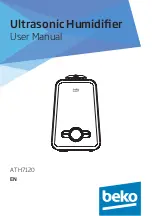
34
Alarms, alerts, and troubleshooting
DreamStation BiPAP autoSV User Manual
3.8 Alarm summary table
The following table summarizes the alarms. See
Alarm and alert LED indicators
and
Alarm and alert audible
indicators
earlier in this chapter for LED and audible indicators for each alarm type.
Alarm
Priority
Device action
User action
Physiological alarms
High
Operates
This alarm occurs when the
calculated minute ventilation is less
than or equal to the alarm setting.
Press the control dial to silence the
alarm. Press the control dial again to
acknowledge and remove the alarm
from the screen.
Report the alarm
to your home care service provider.
Continue using your device.
High
Operates
This alarm occurs when the patient
has not triggered a breath within the
time specified in the apnea alarm
setting. The device continues to
operate. The alarm will automatically
terminate when two consecutive
patient breaths are detected that
meet the apnea alarm time setting.
Press the control dial to silence the
alarm. Press the control dial again to
acknowledge and remove the alarm
from the screen.
Report the alarm
to your home care service provider.
Continue using your device.
High
Operates
This alarm occurs when the patient
circuit is disconnected or has a large
leak. Press the control dial to silence
the alarm. Press the control dial
again to acknowledge and remove
the alarm from the screen. Reconnect
the patient circuit or fix the leak. If
the alarm continues, contact your
home care service provider.
















































